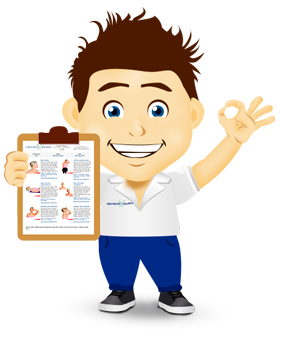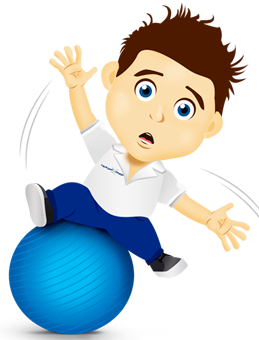
Next steps:
Feel free to read the advice sheet below! To get the full benefit click on 'Start treatment'. By starting the treatment you will get access to weekly rehab programmes online for FREE. You will be able to track your progress, pain levels and we will remind you to do your exercises every day!
The neck is composed of a number of vertebrae that begin within the upper torso and end at the base of the skull. The bony vertebrae, as well as the ligaments (similar to thick rubber bands) and muscles provide the spine with stability. These muscles provide you with motion and support. The neck offers significant movement and supports the head’s weight. Since it isn’t as protected as the rest of the spine, it can be extremely vulnerable to any disorders and injury producing pain and restricting movement. For numerous individuals, pain in the neck is only temporary and disappears over the course of time. Other individuals require treatment to alleviate symptoms and pain.
What Causes Neck Pain?
There are many causes of neck pain. The best way to split up neck pain is by discussing the structure that is causing the pain:
Muscle:
Muscle pains in the neck are incredibly common. They are almost always caused by poor posture. The problem is that our heads weigh quite a lot of weight, but the neck muscles are quite small. So small muscles need to support a heavy weight. The head can actually weigh around 8% of body weight, so that can typically be between 4 and 8 kg. When the head is kept in line with the body (imagine a golf ball sitting on a tee), the actual weight of the neck is easily absorbed by the neck. However, we very much live in a forward facing world with computers, cars, TV’s, smart phones and tablets that encourage us to poke our heads forwards. When the head and neck project forwards in a condition known as forward head posture, the weight of the head can be significantly increased. Researchers believe that for every 1 inch the head is forwards, the weight of the head on the neck muscles increases by 4-5kg. That’s a lot of extra weight going through those small neck muscles, which after a few months fatigue and cause muscle aching and neck pain.
Facet joint:
Facet joints are pairs of joints that occur at every spinal level, so in the neck there are 14 of them. They can be strained or injured, or simply become stiff/locked and inflamed. Facet joint syndrome is a very common neck problem. Typically patients wake up with the pain after sleeping in a funny position, or just a random small movement during the day locks the neck. It’s excruciatingly painful and the neck becomes completely locked with the person unable to rotate the neck without sharp pain.
Disc:
There are seven cervical discs (C1/2, C2/3, C3/4, C4/5, C5/6, C6/7, C7/T1) and these are susceptible to disc bulges, prolapses, or herniation. Basically known as a “slipped disc” in lay terms, the disc protrudes backwards and can pinch a nerve in the neck causing pain to travel down the arm. It’s very common, and becoming increasingly prevalent due to repetitive forward neck bending.
Vertebrae:
The vertebrae and facet joints (and discs) are always susceptible to wear and tear, or osteo-arthritis. Its very common in older age, and can simply just be the normal aging process. However, sometimes the inflammation associated with the condition can flare up and cause patients to suffer a lot of pain. This condition is best diagnosed by checking neck movement, with sufferers having a particularly stiff neck. It also tends to run in families, so if you had a parent with osteo-arthritis there is more chance you will get it too.
Ligaments:
Ligaments are less commonly injured, but can be damaged with forceful movement to the neck such as whiplash injuries.
Neck Pain Anatomy
Inside of the spinal column, there is a tube for the spinal cord. This thick bundle of nerves starts at the base of the brain. It relays information between the brain and the body. Nestled between the vertebrae are the discs. Each individual disc is attached to the bottom of the vertebra that lies above it and the top of the one below it. Muscles and strong ligaments keep the column together. All of the structures work together to surround, protect and support the spinal cord.
How to treat neck pain:
- Medication
Stronger pain medication might be prescribed for you instead of traditional over-the-counter meds. A muscle relaxant is extremely useful for pain. Simply put, medication is good for short term neck pain, but if you find yourself relying on It get to a physical therapist, chiropractor, osteopath or sports rehab specialist who can work out the underlying cause of your neck pain and treat it. Also natural pain relief can be achieved with using ice and heat – ask your therapist for advice.
- Stretching and Neck Exercises
It will be very necessary for you to work with a therapist to learn proper stretches and exercises for the neck. Physical therapists can help to guide you through all of the exercises and stretches, which allows you to do them on your own in the comfort of home. Exercises might improve pain by restoring function in your muscles, increasing the strength and endurance within the muscles and optimizing posture to help prevent overloading any muscles. Its also useful to get hands-on treatment to the neck. Joint mobilisations, manipulation and massage can all provide enormous relief.
- Traction
Traction utilizes pulleys and weights to stretch the neck gently and keep it immobile. Using this therapy with the supervision of a medical professional and therapist will help to provide you with relief from pain, especially when the pain is related to irritation to the roots.
- Short-Term Immobilization
Soft collars supporting the neck help to relieve pain by alleviating pressure from the structures of your neck. If the collar is used for more than two weeks at a time, it might end up stiffening your neck so be cautious.
What you can you do?
You can do the following things to help you to manage your neck pain and aid recovery.
- Stay active: Gradually start to increase your normal daily activity can help to reduce your stiffness and pain and improve physical function. Gentle neck movement will help to relieve pain and stiffness.
- Heat: Apply heat thereafter to help ease muscle spasm, joint stiffness and aid the healing process. Use a hot water bottle, wrapping it in a towel before applying alternatively have a hot bath. Applying for 15-20mins and use regularly.
- Posture: Change activities and position frequently 20-30mins. Lying, sitting, standing or walking for too long may cause stiffness and discomfort. This should improve with time.
- Sleep: You may have difficulty sleeping. Try sleeping with one pillow under you head to keep you head in a neutral position.
- Regular exercise and physical activity: This helps to keep your neck fit and healthy. Walking, swimming and yoga are popular, but it is important to do an enjoyable activity that you can benefit from without making your pain worse. Reduce inflammation by using an ice pack for 5-10 minutes at a time three to five times per day.
- Taking a warm shower can help to relax any sore muscles in the neck.
- Ask your employer for a work place ergonomic assessment. Making small changes to the set-up of your computer can make a big difference over a period of weeks and months.

- Be careful with repeated laptop and tablet use. It encourages you to forward neck bend and places stress through the muscles and discs.

